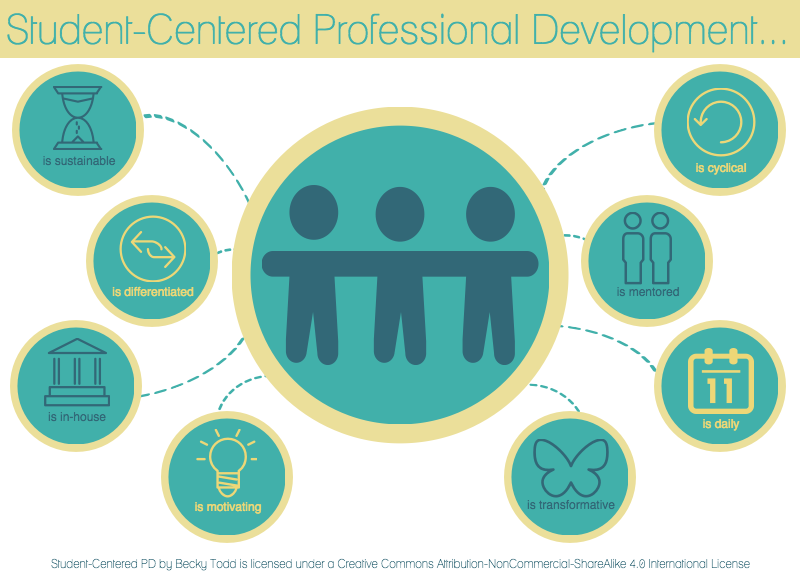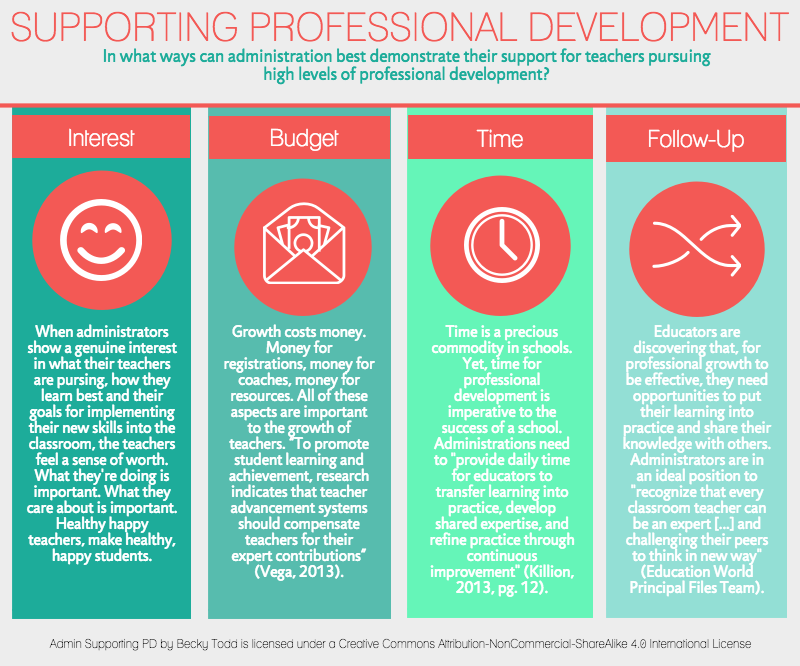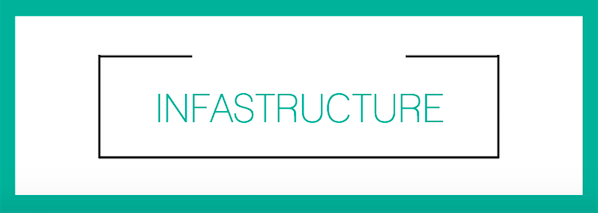This quarter in the Digital Education Leadership program at Seattle Pacific University I am focused on the fourth standard of the ISTE Coaching Standards, Professional Development and Program Evaluation:
Technology coaches conduct needs assessments, develop technology-related professional learning programs, and evaluate the impact on instructional practice and student learning.
Over the last several weeks, my classmates and I have learned how to implement a successful professional development program and I have identified the following elements as being most useful when evaluating a professional development program:

Sadly, professional development is generally “something that is ‘done’ to teachers” (Pilar, 2014). Teachers need opportunities to explore their own interests and venture into those topics at a personalized level that works for their individual learning styles. In a study conducted by the Center for Professional Education, it was found that “90% of teachers reported participating in some form of professional development, and they also reported that it was not helpful in their practice. Thus, professional development is happening, but it is not effective” (Blattner, 2015). Imagine a place where teachers drive their learning by expressing their interests, learning at their own pace, implementing their discoveries and reflecting on their current and future practices. After all, “Professional development should be all about teachers and administrators engaging as learners themselves, and helping them grow as professionals in their field, learning about how to do their job even better, and make a difference in the lives of even the hard to reach children” (Hoffman, 2014).
One option for providing teachers with personalized, interest-driven professional development opportunities is by implementing a peer mentoring program. A mentorship program allows teachers to implement changes and take risks with the support and accountability of their colleagues: “Professional development is not about gurus preaching, it’s about teachers teaching. Personalized professional development is helping educators become deeper thinkers in their practice” (Sampson, 2015).
These “one-on-one experiences [provide] the support that really [makes] a difference: the nagging and nurturing from a highly skilled fellow teacher who [observes] and [supports] in a non-threatening, non-evaluative way” (Eisenberg, 2010). Instead of one-off workshops, “Instructional coaching is basically advice and counsel designed to meet the needs of a specific teacher. On-site coaches work one-on-one with teachers to help them understand what data to collect, analyze, and use to improve instruction. Intensive collaboration and planning occur between coach and teacher before, during, and after a teacher’s lesson, to ensure high-quality instruction appropriate to meeting the needs of all the students” (Eisenberg, 2010).

In a time when education is rapidly shifting and student learning is focused on reaching each individual child, how can teacher learning not follow that same path? School librarian and author, Ernie Cox (2010) has found that, while it has taken decades, “Educators are finally realizing that teachers learn best under the same conditions that are advocated for students” (pg. 33). Up until this point, in a world where “everything from book buying to online dating is personalized, why does professional development for teachers often seem so, well, cookie-cutter?” (Reid, 2015, pg. S2). So, we know that the status quo is no longer working and we are in the midst of finding ways to alter our learning for students, that same shift needs to happen for professional development:


Administration can truly be the make-or-break factor in teacher (and student) success: “Leadership is second only to teaching among school-related factors that can improve student achievement” (Vega, 2013). By looking at the specific elements of how an effective leader can improve both teacher and student achievement, it is easy to see how they make all the difference:
- “A vision of academic success for all students based on high expectations
- A safe and cooperative climate for learning
- Support and training to promote continual professional learning
- Data to track and promote collaborative inquiry and practices that improve student learning
- Cultivating leadership in staff, parents, and community partners” (Vega, 2013).


It is no secret that education is moving towards heavy use of technology, it is also no secret that much of that technology is often plagued with problems. One author poignantly describes the use of technology in a classroom like “sucking peanut butter out of a straw” (Boss, 2014). With the heavy emphasis on educational technology, the first steps to successful innovation is the groundwork, the infrastructure. In a 2011 Federal Communications Commission survey, “Eighty percent of respondents […] said their broadband connections did not fully meet their needs […] and more than half of teachers surveyed reported that slow or unreliable Internet access prevents effective use of technology in their classrooms” (U.S. Department of Education, 2014, pg. 8).
So, where do you start? The first step is to identify “a strong planning team, the next step is to assess the capacity of current network infrastructure and devices, gauge current levels of usage, and estimate the demands needed in the future. This assessment will help you determine which parts of the current infrastructure need to be replaced, upgraded, or supplemented” (U.S. Department of Education, 2014, pg. 11). The main goal of this statement is to “identify a strong planning team.” Who is ultimately responsible for driving the charge of overhauling the infrastructure? Who do the teachers turn to with questions and concerns? Who makes the final decisions? Who is guiding the “vision for learning that technology will be supporting”? (U.S. Department of Education, 2014, pg. 12). How do schools determine where to start when revamping their digital learning infrastructure? They identify a team that is responsible for leading the way.
Conclusion
A strong professional development program is the key to a teacher’s success and a successful teacher helps to create a successful student. With a trustworthy mentoring program, in which teachers can find in-house support for risk-taking, strong administrative support, and a reliable infrastructure, teachers (and thereby, students) can flourish!
References
Blattner, S. (2015, January 16). SAMR – design learning for engagement, part 3 – professional development [Blog post]. Retrieved from http://tamritz.org/samr-design-learning-pt3-pd/
Boss, S. (2014, December 8). Is your school #futureready? [Blog post]. Retrieved from http://www.edutopia.org/blog/your-school-futureready-suzie-boss
Cox, E. (2010). Critical friends groups: learning experiences for teachers. School Library Monthly, 27(1), 32-45. Retrieved from ERIC database.
Eisenberg, E. (2010). Personalizing professional development. Education Week, 29(32), 30-31. Retrieved from http://www.edweek.org/ew/articles/2010/05/19/32eisenberg.h29.html
Generation Ready. (n.d.). Raising student achievement through professional development. Retrieved January 27, 2016, from http://www.generationready.com/wp-content/uploads/2013/10/PD-White-Paper.pdf
Hoffman, W. (2014, January 12). Meeting the professional development needs of teachers [Blog post]. Retrieved from http://www.edutopia.org/groups/education-leadership/674606
Pilar, C. (2014, January 12). Re: Meeting the professional development needs of teachers [Blog comment]. Retrieved from http://www.edutopia.org/groups/education-leadership/674606
Reid, K. S. (2015). Long Beach sets course to personalize PD options. Education Week, 35(6), S2-S3. Retrieved from Academic Search Premier database.
Sampson, R. (2015, May 3). Capture, curate, share: building a personalized PD culture [Blog post]. Retrieved from http://gettingsmart.com/2015/05/capture-curate-share-building-a-personalized-pd-culture/
U.S. Department of Education. (2014). Future ready schools: building technology infastructure for learning. Retrieved from https://tech.ed.gov/wp-content/uploads/2014/11/Future-Ready-Schools-Building-Technology-Infrastructure-for-Learning-.pdf
Vega, V. (2013, January 3). Teacher development research review: keys to educator success [Blog post]. Retrieved from http://www.edutopia.org/teacher-development-research-keys-success
Your post is wonderful, Becky! Each of your elements play an important part towards a successful professional development program. Your chart on “Supporting Professional Development” is a great visual and highlights four significant points that should be addressed by administrators. I found Vanessa Vega’s blog post very interesting as it examines how school leaders can promote both teacher and student achievement. Thanks for sharing this resource. Great job, Becky!
Nice job integrating so many of the key points from your weeks of work. It is fascinating that we rarely connect how students learn best to how adults learn best. Your visual of interest, budget, time and follow-up are also a really useful summary of some of the most crucial, though often forgotten, elements of professional learning! Great job!
I am currently writing my Professional Growth Plan for SPU so I find myself quite fortunate to have stumbled upon this valuable resource. The feedback you have provided in our EDTC class along with the wealth of knowledge that have shared and continue to share in this website is truly remarkable. Thank you for a wonderful Spring quarter and happy teaching, Becky!
It was great having you in class, Andy. Your students are in good hands!